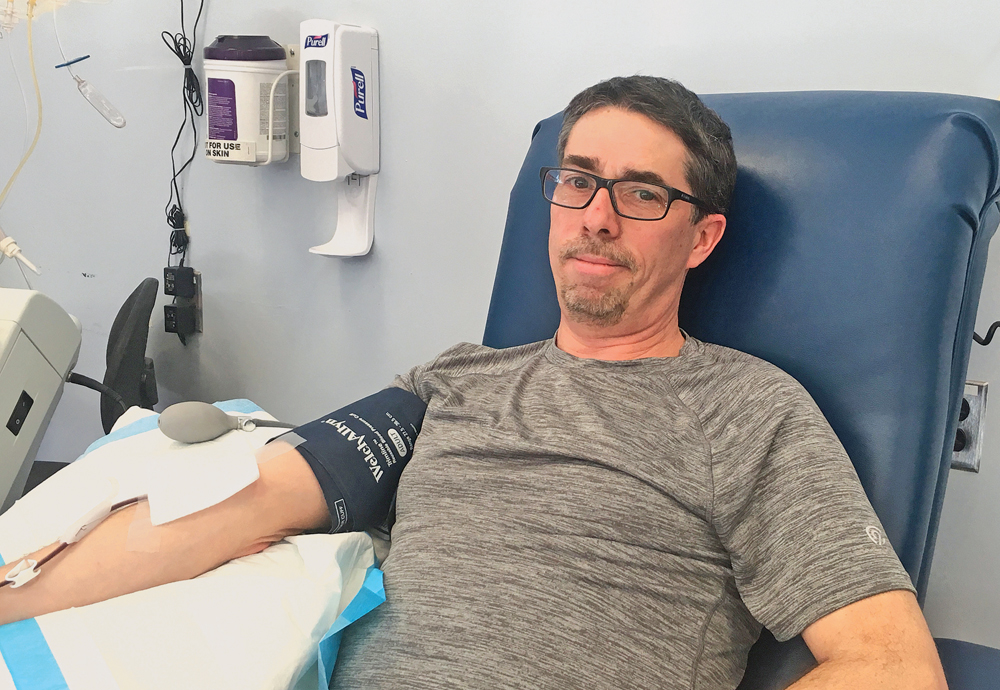Column: Saving a life, one donation at a time

A framed Newsday obituary for George Wybenga, a painter and longtime educator, hangs in the hallway at the Stony Brook University Hospital Blood Bank. The 2016 article details his journey to the United States as an immigrant during World War II and the paintings he created as an artist until he died at 79.
What the obituary doesn’t mention is the frequent trips Mr. Wybenga would make to Stony Brook to donate platelets, the blood component that helps control bleeding, which are used to treat a variety of diseases, and especially for cancer patients. In all, he made more than 300 donations. For the nurses and staff at the blood bank, the small group of regular donors like Mr. Wybenga become like family. They are a dedicated group, willing to sacrifice a couple of hours for each donation to play a small part in saving the lives of people they will likely never meet.
Last Thursday, Robert Verbeck, a fifth-grade teacher in the Shoreham-Wading River School District, arrived at the hospital where he’s been so many times before. Wearing a gray T-shirt and jeans, the 53-year-old relaxed in a chair as a nurse connected his arm to a machine that would filter blood out of his body and then back in for nearly two hours, a process that spins the platelets out while preserving his blood. Unlike regular blood donations, for which two-month intervals are required, donors can repeat the platelet process every two weeks, allowing up to 24 in a year.
Asked how many times he has donated, Mr. Verbeck, who lives in Sayville, thought off the top of his head for a second and settled on 110.
“Would you like me to look it up?” the nurse asked.
“I’m actually curious as to how far off I am,” he responded.
When he had donated for the 100th time, the staff celebrated by presenting him a plaque. It’s a rare feat for someone to donate so frequently.
A few minutes later, the nurse revealed the precise figure: 114. Each donation can be used for up to three patients, meaning Mr. Verbeck may have helped as many as 342 people.
He began donating blood a little over a decade ago. He would do it a few times a year. He had heard about platelets and his father, John Eaton, had become a frequent platelet donor, repeating the process every two weeks at Stony Brook like clockwork. A retired New York City police officer, Mr. Eaton would encourage his son to consider donating platelets.
To this day, Mr. Verbeck doesn’t know for sure exactly why his dad was so persistent in his willingness to donate platelets.
“He was a cop to serve,” Mr. Verbeck said. “That was just the kind of guy he was. He believed in helping people out.”
Ten years ago, Mr. Verbeck’s father died. A few years earlier a close friend of Mr. Verbeck’s who had been living in Denver was diagnosed with cancer. He realized strangers were donating to help save his friend. He thought he could do the same here. That’s what led him to begin donating platelets, and his father’s death reaffirmed his commitment to continue for as long as possible.
“There’s a connection both to my friend Nancy [who died 11 years ago] and my dad every time,” he said. “Because my dad was a good guy, and I want to kind of honor that, but also that feeling that I want to keep the supply going.”
All the platelets donated at Stony Brook’s blood bank are used for patients at the hospital, where patients from across the East End with serious injuries are treated. The platelets remain viable for only five days so supplies are always in demand.
“We never have enough donated platelets or blood,” said Linda Pugliese, who’s worked as a donor recruiter at the hospital for the past two years.
Dr. Tahmeena Ahmed, an assistant professor at Stony Brook’s School of Medicine, said platelets help prevent excessive bleeding in patients suffering from a trauma, for example, and are also used in treating chronic illnesses.
“We have a pretty busy trauma center here, we have a cancer center here, so we use them all the time,” Dr. Ahmed said.
The donation process is largely painless, Mr. Verbeck said, and a registered nurse at Stony Brook stays with the donor throughout to make sure everything runs smoothly. Mr. Verbeck, who has two children, ages 23 and 20, with his wife, Donna — a third-grade teacher at Roanoke Avenue Elementary School — said he typically passes the time by reading.
“Someday every one of us unfortunately is going to know someone who needs platelets,” Mr. Verbeck said.
On this particular afternoon, Mr. Verbeck was the only platelet donor on the schedule.
“They make you feel like you’re saving the world,” he said.
Photo caption: Robert Verbeck donates platelets last Thursday at Stony Brook University Hospital’s Blood Bank. (Credit: Joe Werkmeister)
 The author is editor of the Riverhead News-Review and The Suffolk Times. He can be reached at 631-354-8049 or [email protected].
The author is editor of the Riverhead News-Review and The Suffolk Times. He can be reached at 631-354-8049 or [email protected].









